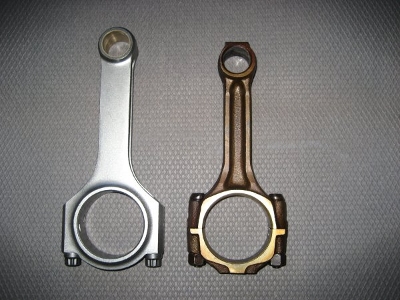Rods
For a mild street engine, particularly a 3" stroke that won't be revved much past 5000rpm the stock red motor rods should be fine. In an engine that won't see much more than say 6500 - 7000rpm use the heavy duty rods from either the 4 cyl Starfire engine or the later blue/black engines - they are the same rod and use a slightly larger bolt than the red rods - 11/32" versus 5/16". However if you're going to be turning 7000 - 7500rpm plus then it would be wise to use something stronger. In the past it was fairly common to use rods from other makers, eg. rods from Mini, BMW, VW Passat and Toyota engines have all been used, but considering the reasonable price of some of the aftermarket rods it would probably be better to take this route instead. Aluminium rods would normally be a good choice for an engine like the little six, for their light weight as well as their shock-dampening capacity, but the close proximity of the camshaft to the crank makes fitting the bulky aluminium rods difficult.
Always replace the rod bolts when stripping and reassembling the engine, the aftermarket ARP bolts are the usual choice.
Aftermarket rods give us the option of using a longer rod for a better rod:stroke ratio so we might as well take a quick look at this. A longer rod is desirable at high rpms; it makes for slower piston velocities to and from TDC (with a corresponding increase around BDC) and this gives slightly higher average combustion pressures as well as less side loading on the Holdens slightly fragile cylinder walls. Another advantage of a long rod is that the slower piston movement from TDC is less likely to put the Holden intake port into a choke situation at a given rpm. The stock rod ratio is barely reasonable on the 3" stroke engines; on the 202s though it's definitely on the short side and it's certainly worth looking at for higher rpm work. Before you go ordering special rods though there are some practical considerations to think about. Firstly the increase in rod length has to be quite large to have any appreciable effect - it's unlikely that a rod of only 5mm or so extra length would make measurably more power, though another 15 - 20mm or so would help. But this leads us to another problem, the piston. Obviously a longer rod will require a piston with a higher pin position, but there are limits to how far this can be taken. The side load from the rod angularity is transmitted to the cylinder wall via the gudgeon pin and piston skirt, and ideally the pin would be positioned exactly half-way up the skirt to maintain durability and minimise drag and piston rock. Moving the pin centreline towards the piston crown puts side loads on the ring pack, a part of the piston poorly suited for this duty. Piston rock at TDC will increase while ring seal and durability will decrease.
What I'm getting at is this: substantially longer rods will improve performance, but only if a reasonable pin position can be maintained. The deck height of the Holden block allows for using rods of up to about 5.9" long with a 3-1/4" crank and reasonably proportioned pistons. But if using longer rods also meant using ugly pistons I'd just forget about it and stick with rods closer to the stock-length. This pin position issue (along with an excessively short rod ratio) also arises with stroker engines, and again it would pay to do whatever was necessary to keep the pin as close to the middle of the skirt as possible, perhaps by slightly crowding the ring pack towards the crown. In extreme cases a special piston could be made with a single compression ring positioned as high as possible, and with the oil ring below the pin.
Stock rods - including Starfires - use a pressed in gudgeon pin. This seems to work well even with fairly big increases in speeds and horsepower, but in an all-out engine floating pins will be less likely to gall the pin bores of the piston. Starfire rods have had the little end bored for bronze bushes successfully in the past, but the wall thickness will be very thin after this operation and I'd be a bit nervous about doing it. Quality control isn't all that flash with the Holden rods and some of the pin bores end up being quite a bit off centre. If you must bush Starfire rods try to find rods that have a uniform amount of material around the little-end eye.
 |
| A 5.71" Eagle rod on the left, a stock Starfire on the right. Note how poorly the little-end eye is centred in the Holden rod. |